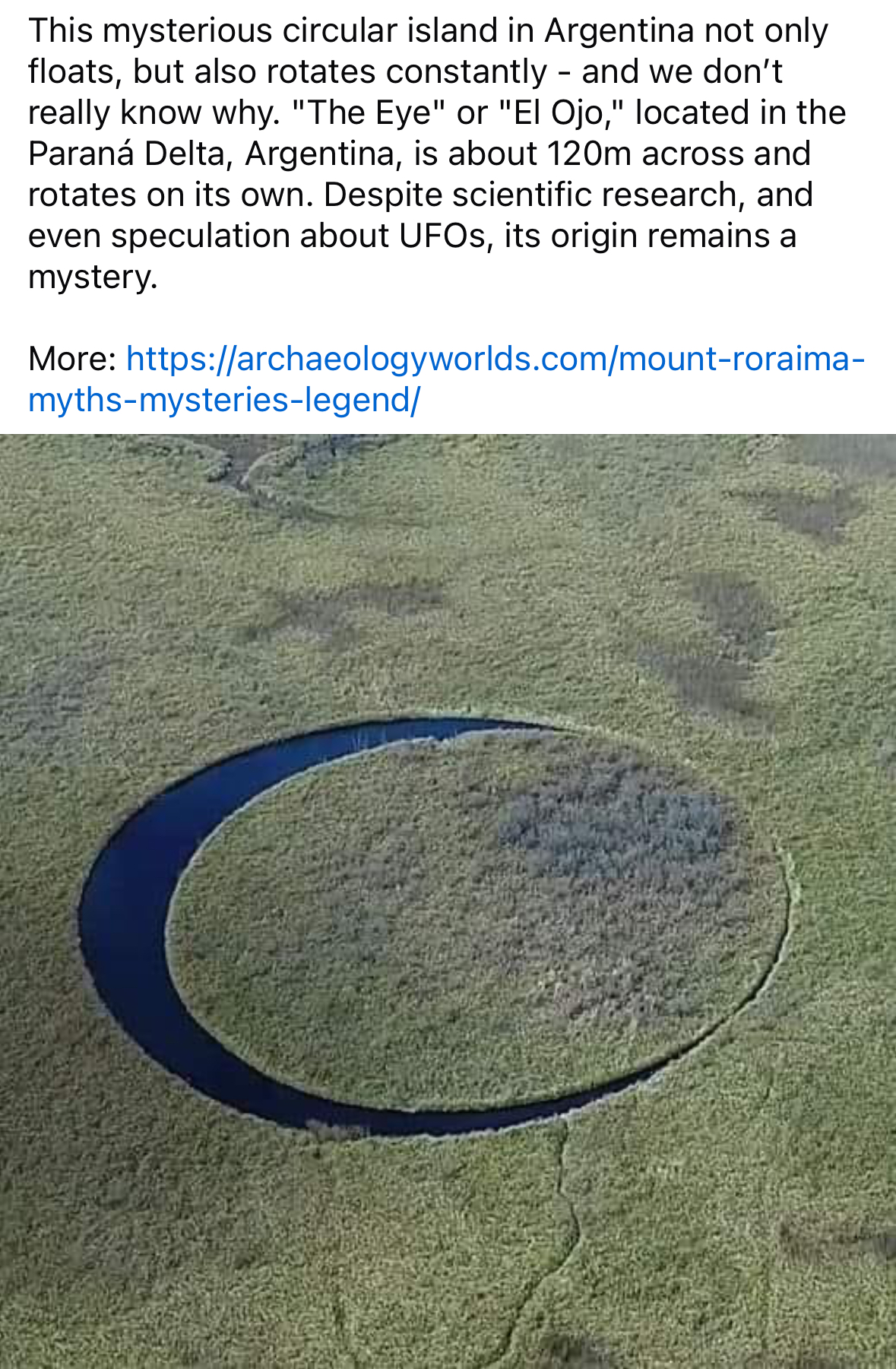 Go To Parent Map
Go To Parent Map
Parana delta el ojo
Stewarded by kahlil | Get Directions
El Ojo: The Mysterious Island of the Paraná Delta, Argentina
The Paraná Delta, one of the world’s largest and most biodiverse river deltas, is home to a mysterious, almost mythical island known as El Ojo (The Eye). Located deep within the dense wetlands of northeastern Argentina, this peculiar formation has captured the imaginations of explorers, paranormal enthusiasts, and scientists alike. What sets El Ojo apart is not just its eerie beauty but its unique and seemingly impossible shape—a near-perfect, circular landmass that slowly rotates in the middle of its own small pond.
The Enigma of El Ojo
First discovered in 2016 by Argentinian filmmaker Sergio Neuspiller while scouting for a location for a horror movie, El Ojo immediately stood out due to its perfectly circular shape. Satellite images reveal a landmass about 120 meters in diameter, surrounded by a narrow channel of water that separates it from the surrounding swampy land. What made this discovery even more intriguing was its apparent ability to rotate. Dubbed El Ojo for its resemblance to a giant eye staring up from the wetlands, it quickly garnered attention from a global audience.
The initial question was simple yet puzzling: how could a landmass this shape and size exist naturally in such a dynamic environment? Further research into its geology, hydrology, and possible origins has only deepened the mystery.
Geographic and Geological Features
The Paraná Delta is a labyrinthine network of rivers, swamps, and islands, constantly changing due to sediment deposits and shifting watercourses. Most islands in the delta are irregular in shape, formed by the slow accumulation of soil and vegetation carried by the rivers. However, El Ojo breaks this pattern. The island is almost perfectly round, and so is the water channel that encircles it, maintaining a consistent width throughout.
One theory suggests that the island is a naturally occurring peat bog, a floating mass of soil and vegetation loosely anchored to the riverbed. This would explain its ability to move slightly, pushed by water currents or shifting sediments. However, this theory has been criticized due to the island’s unusual stability and precise shape.
The Rotational Phenomenon
The most perplexing feature of El Ojo is its slow, steady rotation. Though not perceptible to the naked eye, time-lapse footage and satellite imagery over the years have shown that the island rotates around its own axis. Some have theorized that this could be caused by underwater currents or shifts in the sediments below, which gradually push the island in a circular motion. Others suggest that geothermal or magnetic forces might be at play, but no definitive evidence has been found to support these ideas.
Theories and Speculation
The discovery of El Ojo has given rise to a multitude of theories, ranging from the scientific to the fantastical. Some researchers speculate that the formation could be a unique type of geological phenomenon, possibly linked to tectonic movements or a quirk in the delta’s hydrology. However, due to the remote and difficult-to-navigate nature of the surrounding wetlands, comprehensive field studies have been rare.
More speculative theories propose that El Ojo could be a man-made structure, perhaps the remnants of an ancient civilization or a long-forgotten engineering project. Some even suggest that it could have been used as a navigation or ritual site by indigenous peoples. Its precise, geometric shape lends a certain allure to these hypotheses, but no archaeological evidence has been found to substantiate them.
Paranormal enthusiasts have taken the mystery a step further, claiming that El Ojo might be a hidden entrance to an underground base or even a UFO landing site. While these theories have no basis in scientific fact, they’ve contributed to the island’s growing legend and made it a popular subject of online forums and documentaries.
Ecological Importance and Preservation
Beyond its mystery, El Ojo is situated in one of Argentina’s most ecologically rich and fragile regions. The Paraná Delta is home to a wide variety of flora and fauna, including several endangered species. As human activity encroaches on the wetlands—through agriculture, urbanization, and tourism—the delta’s delicate ecosystems are increasingly at risk.
Because of its remote location, El Ojo has remained relatively untouched by human hands. However, as interest in the island grows, concerns about potential environmental damage are mounting. Local conservation groups have advocated for limiting access to the area to protect its unique landscape and biodiversity.
A Place of Wonder and Mystery
El Ojo is more than just a geographical curiosity—it’s a symbol of the mysteries that still exist in our world, even in an age where satellite imagery and scientific inquiry have demystified so much of the natural environment. Its perfect shape, slow rotation, and the myriad of unanswered questions surrounding it make it a tantalizing subject for both researchers and dreamers.
Whether El Ojo is a geological anomaly, a man-made relic, or simply a natural oddity, it serves as a reminder that nature still holds secrets waiting to be discovered. For now, El Ojo will continue to gaze silently up from the depths of the Paraná Delta, inviting all who see it to look closer and wonder what might lie beneath its tranquil surface.
Featured Image

Content Locker
Attached Files
No media files yet

Video
No video Comments yet